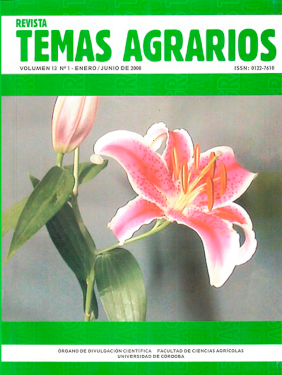Study of contamination by organochlorine pesticides in the cienaga grande waters of the low sinu river valley
Estudio de la contaminación por pesticidas organoclorados en aguas de la ciénaga grande del valle bajo del río Sinú

This work is licensed under a Creative Commons Attribution-NonCommercial 4.0 International License.
Show authors biography
The geographic location of the Cienaga Grande allows the run-offs water from the sewers and natural or artificial water affluent establishing an exchange with the Sinu river in the dry and wet seasons. A considerable amount of chemical compounds are deposited in a direct and indirect way in the waters; therefore, the objective of the present work was to evaluate the contamination with organochlorines pesticides in the waters of the swamp. A Perkin Elmer Autosystem XL gas chromatograph equipped with an electron capture detector (ECD) and a RTX-1 capillary column were used to collect de data. α-BCH, β-BCH, γ-BCH, aldrin and heptachlorine epoxy were detected in the water samples. The determination coefficients (r²) were established using a certified standard pesticides mixture and was below 0.999 in all cases. The detection limit of the pesticides was established in the range from 0.003 to 0.311 µg L-1. The precision method was evaluated based on the relative standard deviation and in all cases was below 7%. The accuracy was evaluated as the recovery percentage and ranged between 72 and 98%. The study showed that all detected pesticides in every sample stations were above legal limits, according to Colombian regulations.
Article visits 5643 | PDF visits
Downloads
- Argumedo, C. y Uparela, P. 2007. Validación e implementación de un método para determinación de pesticidas organoclorados en aguas, peces y sedimentos mediante la técnica de cromatografía de gases con detector captura de electrones. Tesis Pregrado, Universidad de Córdoba, Montería.
- Betancourt, J. y Ramírez-Triana, G. 2005. Estudio de los procesos relacionados con la presencia de plaguicidas organoclorados en la Ciénaga Grande de Santa Marta. Boletín de Investigaciones Marinas y Costeras 34:(1)121-139
- Courtney, D.; Andreas, S.; Mark, D.; John, R.; Vincent, L.; Alyson, L.; Kerry, E.; James, L.; Dana, B.; Larry, L. y Donald, G. 2003. Comprehensive solid-phase extraction method for persistent organic pollutants. Validation and application to the analysis of persistent chlorinated pesticidas. Analytical Chemistry 75(1):71-77
- CVS (Corporación Autónoma de lo Valles del Sinu y San Jorge) y UDEA (Universidad de Antioquia). 1993. Estudio Ecológico y Ambiental Ciénaga Grande de Lorica .CVS, Monteria, 250p.
- CVS. 2006. Diagnostico Regional de Producción Más Limpia. http:// www.cvs.gov.co/descargas/ PROYECTOS%20EXITOSOS.pdf. [Accedido: 03-15-08]. EPA (Environmental Protectión Agency). 1996A. Method 8081 A. Organochlorine Pesticides by Gas Chromatography. EPA, Washington, 44p.
- EPA (Environmental Protectión Agency). 1996B. Method 3520 C. Continuo Liquid– Liquid extraction. EPA, Washington, 8p.
- FAO (Organización de las Naciones Unidas para la Agricultura y la Alimentación). 2002. Programa de Desarrollo Sostenible de la Región de la Mojana. Departamento de Planeación Nacional, Bogotá, 207p.
- García, R. y Repetto, M. 1997. HCH and DDT residues in drinking water from the South of Spain, 1991–1994. Bulletin of Environmental Contamination and Toxicology 59:875-881
- Hernández, L.; Fernández, M. y González, M. 1992. Organochlorine pollutants in water, soils, and earthworms in the Guadalquivir river, Spain. Bulletin Environmental Contamination Toxicology 49:192-198
- IDEAM (Instituto de Hidrología, Meteorología y Estudios Ambientales). 1998. El medio ambiente en Colombia. IDEAM, Bogotá, 495p.
- Jantunen, L. y Bidleman, T. 1998. Organochlorine pesticides and enantiomers of chiral pesticides in Arctic Ocean water. Archives of Environmental Contamination Toxicology 35:218-228
- Lehotay, S.; Harman-Fetcho, J. y McConnell, L. 1998. Agricultural pesticide residues in oysters and water from two chesapeake bay tributaries. Marine Pollution Bulletin 37(1, 2):32- 44
- Mejias, J. y Jerez, J. 2006. Guía para la toma de muestras de residuos de plaguicidas agua, sedimento y suelo. Instituto de Investigaciones Agropecuarias. Centro Regional de Investigación Carillanca, Santiago de Chile, 34p.
- Minambiente (Ministerio de Ambiente, Vivienda y Desarrollo Territorial). 2007. Resolución 2115. Por medio de la cual se señalan características, instrumentos básicos y frecuencias del sistema de control y vigilancia para la calidad del agua para consumo humano. Ministerio de Ambiente, Vivienda y Desarrollo Territorial, Bogotá, 2p.
- Raldúa, P. 1995. Estudio de la Contaminación por plaguicidas organoclorados y mercurio en la ictiofauna de los ríos Altoaragoneses Gállego y Cinca. Tesis Ph.D., Universidad de Zaragoza, Zaragoza
- Rico, M.; González, M.; Hernández, L. y Baluja, G. 1983. Contaminación organoclorada en aguas del Parque Nacional de Doñana y zonas adyacentes. Memorias V Congreso Nacional de Química Orgánica, Tenerife, 3:555-563
- Verano, E. 1998. Estado y realizaciones de la gestión ambiental en Colombia. Ministerio del Medio Ambiente, Bogotá,195p.
- Wolf, M.; Toniolo, P.; Lee, E.; Rivera, M. y Dubin, N. 1993. Blood levels of organochlorine residues and risk of breast cancer. Journal of the National Cancer Institute 85(8):648-52.




















